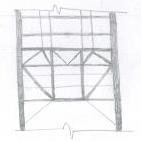-
Posts
1470 -
Joined
-
Last visited
-
Days Won
445
Reputation Activity
-
 UmarMakhzumi reacted to mjnasar in Torsion Longitudinal Reinforcement
UmarMakhzumi reacted to mjnasar in Torsion Longitudinal Reinforcement
ASK
According to ACI, Torsion longitudinal reinforcement should be equally distributed to the 4 faces of the beam
and
ACI 318 says that the torsion reinforcement is additive to the required flexural reinforcement
in your case, u can distribute the steel in 2 top corner bars + 1 side bar + 2 bottom corner bars
( Addl to top & bottom Flexural reinforcement )
regards
-
 UmarMakhzumi got a reaction from MIK in Dynamic Analysis
UmarMakhzumi got a reaction from MIK in Dynamic Analysis
Depends upon what kind of analysis you are doing and what parameters are you looking for, e.g. If you are checking pump vibrations on a steel skid, it doesnt matter what your modal mass participation is and what your primary modes are. All you care is what modes fall closer to the forcing function that would resonate the pump.
-
 UmarMakhzumi got a reaction from Faisal Sh A in Meshing in Etabs - Why do we do meshing
UmarMakhzumi got a reaction from Faisal Sh A in Meshing in Etabs - Why do we do meshing
WS Farooq,
Very good question. Meshing is critical to carry out a finite element analysis as analysis is done on certain points (nodes/ mesh corners) and results are interpolated between adjacent nodes. Without meshing, results would be too vague. I have attached a document that explains the logic behind meshing and its affects on analysis. Please have a read. Then you will be able to understand why your results are different for case when you did meshing and when you didn't.
Thanks.
Why do we do meshing.pdf
-
 UmarMakhzumi reacted to Badar (BAZ) in UBC 97 Response Spectrum Seismic Provisions
UmarMakhzumi reacted to Badar (BAZ) in UBC 97 Response Spectrum Seismic Provisions
Yes, you need to scale down.
-
 UmarMakhzumi reacted to Badar (BAZ) in Structural Dynamics
UmarMakhzumi reacted to Badar (BAZ) in Structural Dynamics
You need to know cross-sectional properties and the unit-weight of the material, and the masses that are not related to self-weight.
-
 UmarMakhzumi got a reaction from Mazhar Amin in Dynamic Analysis
UmarMakhzumi got a reaction from Mazhar Amin in Dynamic Analysis
I have attached tutorials that will show you how to setup ETABS model for dynamic analysis. Go through all tutorials. There are lucid and self explanatory.
OneDrive-2014-03-09.zip
-
 UmarMakhzumi reacted to Syed Usman Aslam in Bi- Axial Bending of Columns
UmarMakhzumi reacted to Syed Usman Aslam in Bi- Axial Bending of Columns
We have been faced with a question, thought to put it on this forum for any comments/guidance
If a column has maximum moments about x- axis when earth quack forces are applied in y direction and have maximum value of moment about y axis when earthquake forces are applied in x direction and we make two different load cases to cover x and y direction. While design of column will it be considered as bi-axially loaded column or we will design independently for both load cases as uni axial loaded column to explain my point following is the mathematical form
Load case-1
D+L+Ex, it gives P and Myy
Load Case -2
D+L+Ey, it gives P and Mxx
what will be the design condition?
P+Myy+Mxx ( Biaxial Codition)
or
P+Myy and P+ Mxx ( Check for both cases independently)
Please reply
-

-
 UmarMakhzumi reacted to Badar (BAZ) in Beam Column Joint
UmarMakhzumi reacted to Badar (BAZ) in Beam Column Joint
Thank you. The joint of top story, or the joint in which column does not extend.
-
 UmarMakhzumi reacted to Ayesha in BFRP bar as main reinforcement in concrete
UmarMakhzumi reacted to Ayesha in BFRP bar as main reinforcement in concrete
I will suggest that you need to be little careful while working with high strength steel/ materials. How much care you need depends upon how high strength of the material is.
The reason - see figure below. I will be talking in terms of high strength steel. Most high strength steel materiel have very limited ductility so you don't want to hover around the 2% strain limit that we use with conventional rebar as you can see in the example image below as steel is already post yield at 2% strain. Generally while working with high strength rebars, you need to get the stress strain curve and then design the reinforcement based lower strain limit. Say a limit that represents 60% of yield as ductility is limited. Dywidag bars are another example that are used commonly in North America. You can see their stress strain properties here: https://www.dsiamerica.com/products/post-tensioning-systems/bar-post-tensioning-system/steel-stress-level/
-
 UmarMakhzumi reacted to Ayesha in Uplift Pressure and Foundation Design
UmarMakhzumi reacted to Ayesha in Uplift Pressure and Foundation Design
The geotech report excerpt refers to the "minimum foundation pressure due to Dead load" should not be less than 1.0 tons/ft^2. Dead load means dead load from superstructure. You can always clarify with the geotechnical engineer if there is ambiguity.
You can even do it by burying your foundation deeper perhaps the overburden can achieve this much load easily.
-
 UmarMakhzumi reacted to Badar (BAZ) in Strut-&-Tie Modelling in SAP2000
UmarMakhzumi reacted to Badar (BAZ) in Strut-&-Tie Modelling in SAP2000
ACI 318 has dedicated entire chapter on this topic starting from its 2014 edition. Before that, the topic used to be in the appendix of the said code. ACI also a document that can help one use the theory by looking at the solved examples of few scenarios (SP-208: Examples for the Design of Structural Concrete with Strut-and-Tie Models).
-
 UmarMakhzumi reacted to Badar (BAZ) in ETABS: Thin Shell Vs Membrane
UmarMakhzumi reacted to Badar (BAZ) in ETABS: Thin Shell Vs Membrane
Young engineers often ask about whether to select membrane or thin shell or thick shell for modelling area elements such as RCC slab. I am going to talk about the difference in the results when choosing thin-shell or membrane. This is what makers of ETABS says about the topic.
I will quote the following to clear out the structural difference between the two: "Load which is applied to membrane objects transfers directly to supporting structural objects, whereas meshed shell objects have bending stiffness and therefore resist a portion of the load through flexural deformation. As a result, less load will be available to transfer to beams located under a shell, while 100% of the load will transfer through a membrane".
Lets see how much can the results differ. Figure below shows the partial framing plan of a level in the building
I will discuss how the modelling of S11a as thin-shell or membrane will effect the design shear and moment on the beam B54a, see figure above.
The figure below shows the design forces obtained against the gravity loads for the membrane case:
The figure below shows the design forces obtained against the gravity loads for the thin-shell case:
Based on the results presented above, B54a's design shear increased by 155%, and its design moment by 147% as compared to S11a's behavior as membrane.
Now the question, that a Structural engineer needs to ask is: Which result is more appropriate or which result captures the actual behavior more realistically? And that is where you engineering judgement comes into play.
-
 UmarMakhzumi reacted to Badar (BAZ) in Beam Column Joint
UmarMakhzumi reacted to Badar (BAZ) in Beam Column Joint
*SEFP Consistent Design*
*Pile Design*
*Doc No: 10-00-CD-0007*
*Date: April 16, 2018*
1.1. FUNCTION OF JOINT
Beam-column joint must transfer the forces, such as moment, shear and torsion, transferred by the beam to the column so that the structure can maintain its integrity to carry loads for which it is designed.
Another function of the beam-column joint is to help the structure to dissipate seismic forces so that it can behave in a ductile manner.
1.2.WHY DO WE CARE
During an extreme seismic event, the code-based structure is expected to maintain its load-carrying capacity for gravity loads even after the structure deforms into inelastic range so that it does not pose any life safety hazard. Hence, the joint can go through significant degradation of strength and stiffness, and if it fails in shear, or anchorage, the life-safety objective of code cannot be achieved.
1.3.CONSEQUENCES OF FAILURE
1.4.THINGS TO CONSIDER FOR BEAM COLUMN JOINT
Longitudinal bars of beams, or slab, must be able to develop their yield stress, so that the beam/slab can transfer moment to joint. It means that longitudinal bars must have adequate development length for hooked bars. This implies that the size of the column must be such that bars can develop their tensile forces. If bars can transfer moment, they can also transfer shear as far as monolithic construction is concerned. The shear strength of the joint must enable the transfer of moment and shear through it. The joint should be Constructible: Congestion of reinforcement is the main concern.
1.5.DESIGN SHEAR FOR BEAM COLUMN JOINT
The design shear for beam-column joint depends upon the relative strength of beam and column at the joint.
For the joints part of the special moment resisting frame, the shear force will be the one that corresponds to the development of hinge in the beam because the frame is required to satisfy strong column-weak beam criteria. If it is a knee joint, then joint area must resist the shear equal to the development of tensile force in the beam. The tensile force will be equal to the product of the area of tension steel, yield strength and the factor that represents the overstrength of steel rebar. If it is not a knee-beam-column joint then, the design shear of the joint will be algebraic sum of tensile force in the beam and the column shear. The column shear is the one that is required to keep the joint in equilibrium, i.e the shear corresponding to the development of the probable moment capacity of beams at the joint.
For the joints not part of the special moment resisting frames, one needs to investigate whether the beam or column will yield first. For knee joint, if the column is weaker then the beam, the tensile force cannot exceed the moment corresponding to the development of hinge in column
1.6.THE JOINT: Definition and classification
Portion of column within deepest beam that frames in to the column (ACI 352-02).
ACI 352-02 categorizes joints based on the displacement-demand imposed by connected members.
· TYPE 1 (Section 2.1.1 ACI 352-02)
These joints possess limited ductility, and hence the connected members are designed for limited ductility. They are used in situations where ductility of structure is not a concern.
· TYPE 2 (Section 2.1.2 ACI 352-02)
These joints connect members which designed to have sustained strength under large deformations.
Joints are also classified based on their location in framing system
1.7.THE JOINT: Design forces
The joint is designed for the shear that results from attainment of the flexural strengths of members connected at the joint for type 2 joints. For type 1 joints, same principle is employed, unless the both members are overdesigned and the engineer does not expect both members, i.e. beam and column, to yield under design forces.
1.7.1. FLEXURAL STREGNTHS: TYPE 2
No strength reduction factor is used for computation of flexural strength. Steel stress is multiplied by factor of 1.25 for computation of flexural strength (3.3.4 ACI 352-02). For type 2 joints, the flexural strength of beams needs to be calculated only, as we do not expect the hinge-formation in columns; we will proportion the beam-column assembly of this joint as per strong-column-weak-beam approach.
The slab reinforcement within the flange of beam must also be considered for computation of flexural strength of beam if the slab is integrally cast with beam and if the longitudinal reinforcement of slab is anchored (3.3.2 ACI 352-02).
For interior connections, and for exterior and corner connections with transverse beams, the portion of slab to be considered as flange should be as per guidelines of section 6.3.2 of ACI 318-14. The effective flange width should not be taken less than 2 times the width of beam.
For exterior and corner connections, without transverse beams, the effective flange width should be as per figures below (section 3.3.2 of ACI 352-02). The effective flange width for this case need not be taken more than 1/12th of the span of the beam.
1.7.2. FLEXURAL STREGNTHS: TYPE 1
For type 1 connection, similar procedure as discussed above should be used, if beams are expected to yield before columns. The stress multiplier factor for this type of connection can be taken as 1.
The beam reinforcement, if any, as per section 24.3.4 of 318-14, with-in the effective flange width, must be included in determination of flexural strength in addition to the web reinforcement.
If columns are expected to yield before beams, the nominal flexural capacity at beam-column joint should be calculated with due consideration given to the axial load on column. The beam moment in that case would be the one required to maintain equilibrium of the connection.
If neither the beam, nor column, is expected to yield at factored loads, then the design shear of joint would be based on factored forces, moments and shear, at beam-column interface.
-
 UmarMakhzumi reacted to Badar (BAZ) in Minimum Area Of Steel In Etabs
UmarMakhzumi reacted to Badar (BAZ) in Minimum Area Of Steel In Etabs
Check following:
Design code assigned in the software RCC design manual of the software and find how it calculates this for the design code of your interest If you still reach at the same conclusion, ignore these results. The software can do that because of some bug. -
 UmarMakhzumi reacted to Badar (BAZ) in Difference in calculating minimum reinforcement when using limitations imposed by aci for beams and slabs
UmarMakhzumi reacted to Badar (BAZ) in Difference in calculating minimum reinforcement when using limitations imposed by aci for beams and slabs
The lower one is not used for footings by practicing engineers. The reason: area element (Slab) has more options to redistribute the load then the line element (beam).
-
 UmarMakhzumi got a reaction from ILYAS in Moment Capacity of retrofitted section
UmarMakhzumi got a reaction from ILYAS in Moment Capacity of retrofitted section
Fatima,
What has been stated above by Baz is very useful and you can use it for composite sections of any given configuration. Generally speaking, strength contributions by steel angles are very low and wouldn't add much to a concrete column section. I have used angles at corner of concrete section to allow welding of lighter items (like small pipes or cable trays) or to protect the corner from deterioration. I would suggest to ignore angles and don't rely on them.
Now lets say you still want to consider the angles, for that case follow what Baz has said. So you can model a composite section or manually calculate the moment of inertia of combined section. By doing that, you can run analysis model and get your moments in the composite member due to the applied loads. Additional checks to do would be to make sure the bolts connecting the angles to the concrete don't fail before your angle attains yield strength. You can calculate the force in the bolts by using the Shear flow formula VQ/I. You will need to check different sections along the length as moment is changing constantly along the length. I hope this helps.
Thanks.
-
 UmarMakhzumi reacted to Fatima Khalid in Moment Capacity of retrofitted section
UmarMakhzumi reacted to Fatima Khalid in Moment Capacity of retrofitted section
Thankyou all.. The people in this forum is always ready to help.. 😇
-
 UmarMakhzumi got a reaction from Fatima Khalid in Moment Capacity of retrofitted section
UmarMakhzumi got a reaction from Fatima Khalid in Moment Capacity of retrofitted section
Fatima,
What has been stated above by Baz is very useful and you can use it for composite sections of any given configuration. Generally speaking, strength contributions by steel angles are very low and wouldn't add much to a concrete column section. I have used angles at corner of concrete section to allow welding of lighter items (like small pipes or cable trays) or to protect the corner from deterioration. I would suggest to ignore angles and don't rely on them.
Now lets say you still want to consider the angles, for that case follow what Baz has said. So you can model a composite section or manually calculate the moment of inertia of combined section. By doing that, you can run analysis model and get your moments in the composite member due to the applied loads. Additional checks to do would be to make sure the bolts connecting the angles to the concrete don't fail before your angle attains yield strength. You can calculate the force in the bolts by using the Shear flow formula VQ/I. You will need to check different sections along the length as moment is changing constantly along the length. I hope this helps.
Thanks.
-
 UmarMakhzumi got a reaction from Badar (BAZ) in Moment Capacity of retrofitted section
UmarMakhzumi got a reaction from Badar (BAZ) in Moment Capacity of retrofitted section
Fatima,
What has been stated above by Baz is very useful and you can use it for composite sections of any given configuration. Generally speaking, strength contributions by steel angles are very low and wouldn't add much to a concrete column section. I have used angles at corner of concrete section to allow welding of lighter items (like small pipes or cable trays) or to protect the corner from deterioration. I would suggest to ignore angles and don't rely on them.
Now lets say you still want to consider the angles, for that case follow what Baz has said. So you can model a composite section or manually calculate the moment of inertia of combined section. By doing that, you can run analysis model and get your moments in the composite member due to the applied loads. Additional checks to do would be to make sure the bolts connecting the angles to the concrete don't fail before your angle attains yield strength. You can calculate the force in the bolts by using the Shear flow formula VQ/I. You will need to check different sections along the length as moment is changing constantly along the length. I hope this helps.
Thanks.
-
 UmarMakhzumi reacted to Badar (BAZ) in Moment Capacity of retrofitted section
UmarMakhzumi reacted to Badar (BAZ) in Moment Capacity of retrofitted section
One way will be to use sections designer in CSi softwares (Sap 2000, ETABS, Csi Col). Model four angles with re-bars by locating them at the centroid of of angles. You will have to define material for that reinforcement. This will be in addition to the existing reinforcement in the cross-section
You can easily calculate the moment-capacity provided by four angles by manual calculation keeping in mind the crushing strength of concrete, and add it to existing capacity.
-
 UmarMakhzumi got a reaction from abbaskhan2294 in Pile Design
UmarMakhzumi got a reaction from abbaskhan2294 in Pile Design
*SEFP Consistent Design*
*Pile Design*
*Doc No: 10-00-CD-0005*
*Date: Nov 21, 2017*
This article is intended to cover design of piles using Ultimate Limit State (ULS) method. The use of ULS method is fairly new for geotechnical design (last decade). The method is being used in multiple countries now (Canada, Australia etc). The following items shall be discussed:
Overview Geotechnical Design of Piles (Compression Loads, Tension Loads and Lateral Loads) Structural Design of Piles (Covering both Concrete and Steel) Connection of Pile with the foundation (Covering both Concrete and Steel) Pile Group Settlement Things to consider
1. Overview
Piles provide a suitable load path to transfer super-structure loads to foundation where shallow foundation are not suitable - this can be due to a number of reasons like existing space constraints or suitable soil strata is not present immediately below structure. Other uses can be to meet design requirements like to have reduced settlement etc.
This article shall cover the use of straight shaft cast-in-place concrete piles and straight shaft driven steel pipe piles. There are a number of additional piles types like belled concrete piles, precast concrete piles, screw / helical steel piles etc but the discussion to choose a suitable pile type is not in the intended scope of this article. The article is intended to discuss design requirements for straight shaft piles only (both concrete and steel) . The aforementioned topic about pile selection is a very diverse subject and requires a separate discussion on its own.
Before I get into the nitty and gritty of pile design, it is important to highlight that as a structural engineer working on pile design, there are a number of parameters that you would require from the geotechnical engineer. Generally, these parameters are provided in the project geotechnical report. Based on those parameters, the geotechnical design of piles is performed first followed by structural design of pile. The next section talks about the geotechnical design of piles.
2. Geotechnical Design of Piles.
Geotechnical design of pile means sizing of pile. This includes determining the following two geometric properties of piles:
1) Diameter or radius
2) Length
Straight shaft piles embeded in soil derive their capacity from two sources. The first one is the skin friction along the pile length and the second one is the end bearing. In order to complete the geotechnical design of piles or in simple words to "size up the piles", you will need skin friction values for different soil strata through which the pile would penetrate or lie and the bearing capacity of the layer in which pile would terminate.
This information is provided by the geotechnical engineer in the project geotechnical report. Generally, they would provide a table showing skin friction values of each soil layer for both tensile and compressive loads along with end bearing values of each layer. In addition to this, for areas susceptible to frost loading, the geotechnical engineer would also provide ad-freeze and frost heave forces. You can't design a pile without knowing what these values are. So this is something that you need from a geotechnical engineer.
Once you have received the project geotechnical report with all the required information, you need to start sizing the piles. The easiest way to do it is to create an excel sheet and do preliminary calculations for different standard diameters like 200mm, 324 mm, 406mm, 460mm, 508mm, 610mm, 762mm and 914mm. The geotechnical report shall also provide recommendations if certain top soil layers need to be ignored or not.
Example Problem:
From your structural analysis, the maximum factored compressive load is 100 kN. and maximum factored tensile load is 50 kN. You need to size a pile (do geotechnical design) to meet that applied load. Sizing piles for geotechnical capacities is simple. Here is the formula for capacity of pile based on skin friction only (ignoring end bearing for simplicity):
ULS Geotechnical Pile Axial Capacity: Pi * Pile Diameter * Total Embedment Length of Pile * Skin Friction Value * Resistance Factor Where,
Pi= 3.14
Pile Diameter = 2* Radius
Total Embedment Length of Pile = Pile Embedment Length - Frost Depth
Skin Friction Values = See geotechnical for values
Resistance Factor = 0.4 for compression and 0.3 for tension.
For, the above problems, lets assume Skin Friction values of 80 kPa for both tension and compression and initial pile size (diameter) of 324 mm, Frost Depth of 3000 mm.
For total length of 10m (lets assume a starting length), Total Embedment Length of Pile = 10m - 3m = 7m (Total Length - Frost Depth)
ULS Geotechnical Pile Compressive Capacity= 3.14 * (0.324m) * 7m * 80 kPa * 0.4 = 228 kN > 100 kN Okay.
ULS Geotechnical Pile Tensile Capacity = 3.14 * (0.324m) * 7m * 80 kPa * 0.3 = 171 kN > 50 kN Okay.
The above problem shows you how to calculate the compressive and tensile capacities (also called the axial capacities) of the pile. For lateral capacity, you will need to know the modulus of sub grade information from the geotechnical engineer and use a software like LPILE to see the response against the lateral load. It is important to note that lateral deflection of pile is a service limit state meaning that it should be checked against unfactored loads.
Generally, for petrochemical and oil and gas industries, pile service loads are defined as a deflection limit that will depend upon the maximum allowable movement of pile considering an elastic response from soil as well as the maximum movement piping and its attachments can take. Here is a scenario explaining that. For example, your geotechnical engineer recommends a maximum lateral movement of pile to be limited to 6mm so that soil around pile stays elastic. The structure you are designing, has a wind load deflection of 12mm. The pipes and equipment plus their connections shall be designed for 6mm+12mm = 18mm movement of structure. You need to notify piping of this deflection limit and if they are okay, you are good. If they are not, you will have to stiffen up the structure to lower the overall structure deflection and work with piping to see alternate routing for pipe. For pile design, you need to see what diameter pile shall have a capacity at 6mm lateral deflection greater than the applicable horizontal service load. To calculate pile capacity for different pile head movements, you will need to use LPILE or similar software.
LPILE shall provide you a graph that would show you that how much a pile would move under applied lateral load or moment. LPILE is very easy to operate. You can look at the program tutorials and work your way through. It will also provide you the analysis results for a pile embeded in soil with soil modelled as springs along the length. This analysis result is important and allows us to see what is the maximum moment and shear developed in pile due to applicable load and based on combined response of soil and pile interaction.
If you don't have LPILE, you can ask the geotechnical engineer, to provide you with pile lateral capacity graphs. In this case, you will need to provide the geotechnical engineer with estimated pile sizes, estimated axial and lateral loads, pile head condition (Fixed or Pinned) upfront. The goetech engineer will run the LPILE for you and provide you the graphs that will show the maximum load a pile can take against different lateral displacement values and would also provide the maximum moment due to max lateral load. I have done this on a number of projects and this is standard industry practice.
3. Structural Design of Piles.
After completing the geotechnical design of pile, the structural design of pile needs to be performed. In order to do that, you will need to know the maximum moment in pile due to the application of axial and lateral loads. As mentioned above, the easiest way is to use LPILE output as it provides you with deformed shape of the pile along with the maximum moments and shears due to applied loads - the analysis of pile embedded in soil. Using LPILE analysis results, you can use beam-column capacity formulas to design a steel pile or column interaction diagram to design a concrete pile. Beam-Column capacity formulas vary with different codes so therefore I haven't included any example. For steel piles, corrosion allowance should be considered as per the code requirements. Generally its 1.5mm each exposed face so for pipe piles it will be 3mm considering exterior and interior face of the pile.
4. Connection of Pile with the foundation (Covering both Concrete and Steel)
The connection of pile and foundation / pile cap is extremely simple for concrete piles. All you need to do is to develop the bars from concrete pile in concrete foundation/ pile cap. For steel piles, similar concept is there, except for you need to weld rebars on top of cap plate.
5. Pile Group Settlement
Single pile or pile groups should always be check for settlement. Geotechnical consultant shall be contacted to get guidance on what method should be used. Methods like equivalent raft method or finite element analysis can be carried out to get settlement numbers.
6. Things to Consider
For pile group, group effects are generally provided by the geotechnical engineer that can be applied to pile group. The group effects are a function of pile diameter and centre to centre spacing. Pile capacities are reduced if they are spaced closely. For straight shaft piles, rule of thumb is to place them greater or equal centre to center distance of to 3 * diameter of pile. For lateral loads, pile capacities are reduced at 3 * diameter spacing and generally piles need to be spaced at 5 * diameter to have no lateral reduction. Also, straight shaft piles if placed too close might result in pile installation issues. Some piles already installed might heave up if other piles are being installed in close proximity. Impact of pile driving to existing structures should also be considered especially if there is sensitive instrumentation installed in close proximity.
Hope this article provides the much needed guidance on pile design. It is written for beginners and a lot of things have been kept simple. Your feedback is more than welcome. Please post any questions should you have.
Thanks.
-
 UmarMakhzumi reacted to SALMAN CH in Pile Design
UmarMakhzumi reacted to SALMAN CH in Pile Design
@UmarMakhzumi.. @Ayesha...Thank You for your concern. Yes we r on the same page . However my interest was only to highlight the fact that pile cap design is not like slab, due to pile spacing criteria and typical patterns, it will behave like a deep beam in almost every structure. However i feel there is no proper technical inputs on this component of structure and engineers follows whatever practices are in their offices.
In this regard i would like to add little knowledge as per my experience , that unlike the normal slab, the critical sections for maximum FORCES will also be changed , it needs 5 to 6 special investigation as per the reference handbook mentioned in commentary of ACI.
Regards
-
 UmarMakhzumi reacted to Badar (BAZ) in Comments/Observations regarding modelling in ETABS
UmarMakhzumi reacted to Badar (BAZ) in Comments/Observations regarding modelling in ETABS
*Comments/Observations regarding modelling in ETABS*
*Doc No: 10-00-CD-0006*
*Date: May 06, 2017*
Some of the observations made during extraction of results from ETABS (v 9.7.4), for design of reinforced concrete members, are being share in this article.,
1) Minimum Eccentricity
ETABS always considers the minimum eccentricity for selecting the design moment of columns irrespective of the probable behavior of the column, whether short or long column. See section 10.10.6.5 and its commentary of ACI 318-08 which deals with minimum eccentricity of long columns. You should always check the design moments that ETABS uses for columns if you want to bring down the cost of construction.
2) Unbraced/ Braced Preference
If your model has lateral loads, ETABS will give you design moments in column irrespective of its status as braced or un-braced as per ACI 318 criteria. You should investigate if the storey under consideration is braced, or un-braced (10.10.5.2), and decide appropriate design moments of columns.
3) Time Period
ETABS has a tendency to select a time period of the building that is considerably less than the value obtained by the approximate method, Method A, of the section 1630.2.2 of UBC 97. To quote the FEMA 451 document: ''Because this formula is based on lower bound regression analysis of measured building response in California, it will generally result in periods that are lower (hence, more conservative for use in predicting base shear) than those computed from a more rigorous mathematical model". So, there is no need to use the value of time period that is lot less than Ta. One should always check the time period used by the software; ETABS can overestimate the seismic force by more than 2 times.
Method A gives lower T and higher V, so FEMA 451 has advised not to use the value of time period less than this value even if rigorous analysis gives a lower value.
I have seen the results where Etabs have use the value of time period less than Ta; in-fact as low as 0.5Ta, which can increase the base shear two times. (For a complete discussion on time period, please see the following this thread that complements this section).
4) Stiffness Modifiers
First thing is related to modelling the bending stiffness of flexural members, for strength level loads, that is representative of their condition near failure. The ACI code specifies the modifier of 0.35 on gross moment of inertia to represent its condition at yielding.
Some people say that the factor should be multiplied by 2 to represent the stiffness of T-beam. This approach would be justified if you are not taking into the account the out of plan bending stiffness of slab.
But, ETABS does include the out of plane bending stiffness if you have modelled the slab by using shell elements. So, a factor of 0.7 would overestimate the stiffness of your structure in this case, and will lead to under-design.
If one has used the modifier of 0.35 in ETABS for beams in beam-slab floor system, then what value should be adopted for slab? It should not be 0.25, as this value has been specified for flat plates and flat sab floor system.
If one is using some value of modifier for out of plane bending stiffness on shells, then the share of the bending moment in beams will be reduced accordingly. This approach is correct if one will be providing the reinforcement in column strips of slab. But, if you are providing reinforcement in slab in the direction perpendicular to supports only, i.e. beams, as is the general practice in Pakistan, then you are under-estimating the flexural demand in beams.
Now, there is also a question of factors to be used while deciding the amount of reinforcement required in beams, columns and shear walls.
If you are using factors 0.35 for beams and shear walls, and 0.7 for columns, then you are finding out the demand in members at the point of yielding, and this conforms to the code. But, this also means that the structure might experience unacceptable cracks widths. So, if you are using 0.35 for calculating the demand at strength-level forces, then you should also perform crack-control-check at service-level loads by using the factor of 1.
If you are calculating the strength-level demand with a modifier of 1 for all structural members, after you have decided the location and the number of shear walls with modifier of 0.35, then you are overestimating seismic forces, as you are underestimating the time-period. But, the structural performance will improve.
This article is based on my two separate posts regarding the subject matter. You can view the discussion on the items raised above by viewing the following links:
1) http://www.sepakistan.com/topic/2008-issues-in-etabs-results/
2) http://www.sepakistan.com/topic/2290-modelling-issuesconsideration-in-etabs/
Thanks.
-
 UmarMakhzumi reacted to Badar (BAZ) in Base Shear Calculation
UmarMakhzumi reacted to Badar (BAZ) in Base Shear Calculation
Mat cannot be part of inertial forces. The slabs with in basements can participate depending upon the level of grade on both sides of building, the stiffness of basement walls or other below-grade vertical members and type of soil. You can take a look at this document:
asce-003_asce_7-10_commentar.pdf
https://cdn.ymaws.com/www.nibs.org/resource/resmgr/bssc/asce-003_asce_7-10_commentar.pdf






